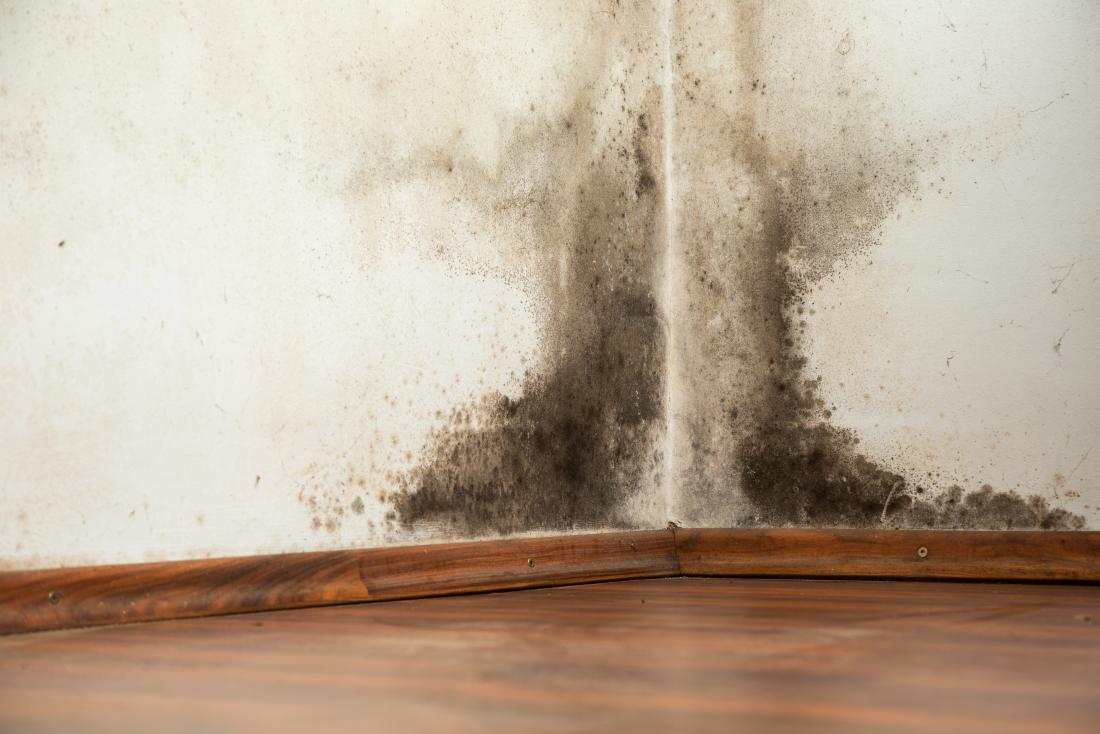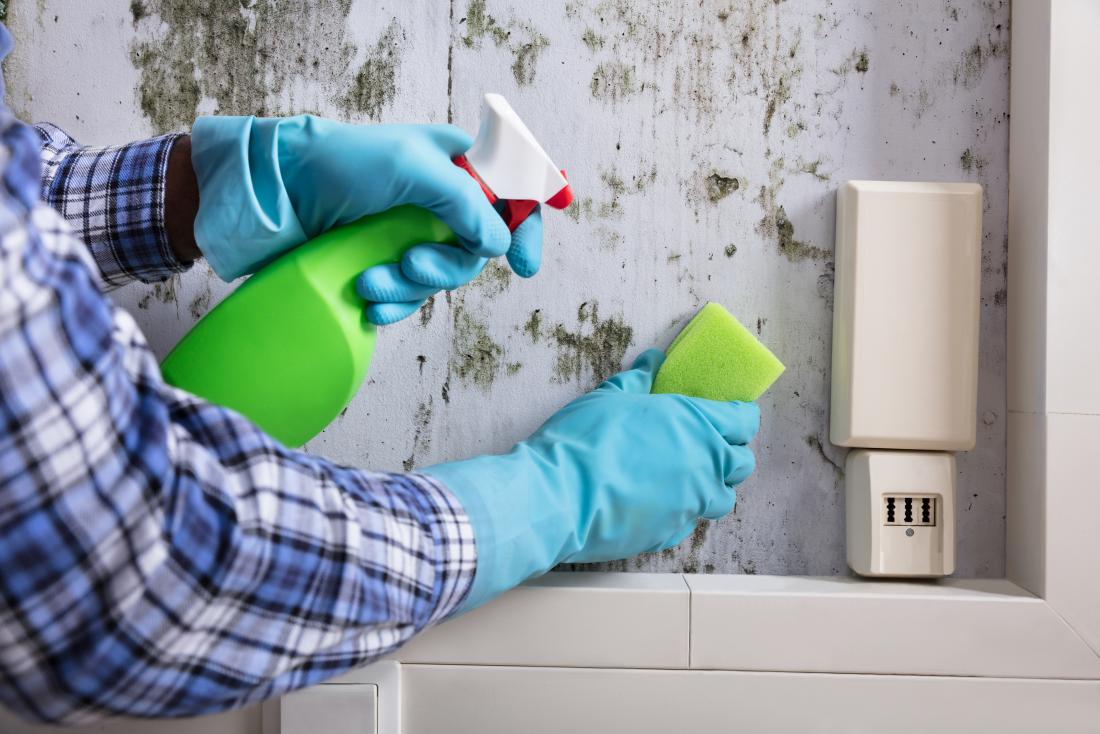In this article, we explain what black mold is and look at the effects it can have on a person’s health. We also discuss how to treat and prevent black mold exposure.
What is black mold?

Some molds can release mycotoxins.
Black mold is a type of fungus that is very dark green or black and often has a distinct musty or damp, mildewy smell.
Black mold can be one of several different species of fungus, including Stachybotrys chartarum.
It tends to grow on surfaces that contain a lot of cellulose, such as fiberboard, wood, gypsum board, or paper. The mold prefers damp, warm environments, and it can grow wherever the conditions are right.
Black mold often thrives in humid areas, such as bathrooms, laundry rooms, and shower cubicles. It may also appear following a burst pipe or flooding, when it can grow in areas of a building that a person cannot easily see, such as between wall layers or underneath floorboards or carpets.
These molds are not dangerous in themselves, but they can release harmful toxins into the surrounding environment. Inhaling these toxins may lead to certain health effects and symptoms. People with lung disease or weakened immune systems tend to have a higher risk of experiencing these effects.
What is black mold poisoning?
Black mold poisoning is a form of mycotoxicosis, which may occur if a person breathes in too many mycotoxins over an extended period. Mycotoxins are the toxins that some molds release.
The symptoms of black mold poisoning can appear similar to those of an upper respiratory tract infection, such as the flu or common cold. People with other health conditions or a weakened immune system may experience more severe symptoms.
Symptoms
The symptoms of black mold exposure may include:
- coughing
- wheezing
- a stuffy nose
- a runny nose
- red eyes
- itchy skin or eyes
- a sore or itchy throat
- nosebleeds
Black mold exposure can also potentially worsen the symptoms of other respiratory conditions. For example, a person with asthma or a respiratory allergy may find that their symptoms worsen or they experience new symptoms, such as:
- persistent coughing
- headaches
- frequent chest colds
- difficulty breathing
- allergic reactions
- inflammation of the sinuses
- general fatigue and lethargy
In rare cases, long-term exposure to high levels of these toxins may lead to more severe symptoms, including:
- memory loss
- trouble concentrating
- sensitivity to light
- anxiety
- nerve issues, such as numbness in the hands and feet
- general pain and cramps
- unexplained weight gain
- anxiety
At-risk groups
Some people may have a higher risk of developing symptoms than others. At-risk groups include people with:
- asthma
- seasonal allergies, such as hay fever
- mold allergies
- chronic obstructive pulmonary disease (COPD)
People with a weakened immune system also have a higher risk and may need to take extra care to avoid black mold exposure.
Black mold exposure may be more harmful in children. According to the Centers for Disease Control and Prevention (CDC), some research suggests that young children who inhale mold toxins early on in life may be more likely to develop asthma. This seems to be more of an issue in children with a family history of asthma, but additional research is necessary to understand the risks better.
How dangerous is black mold to health?

For people with respiratory conditions, inhaling black mold toxins may trigger flare-ups.
Black mold exposure has the potential to be harmful in the long term, particularly in people with respiratory conditions and other risk factors. However, there are many exaggerated claims of the dangers of black mold on the internet.
In otherwise healthy people, short-term exposure to mycotoxins is unlikely to cause harm. It generally takes time and consistent exposure to black mold for symptoms to develop.
In people with respiratory conditions, such as COPD, asthma, and respiratory allergies, inhaling black mold toxins may have the potential to worsen symptoms or trigger flare-ups.
Diagnosis
The main symptoms of mold poisoning are common to other respiratory disorders, which can make diagnosis difficult.
If a doctor suspects that a person’s symptoms are due to the inhalation of mold toxins, they may order a test to check the levels of mold in their home.
A doctor may also recommend allergy tests or blood tests if they think that an individual has a mold allergy.
Blood tests involve taking a small sample of the person’s blood and sending it to a laboratory for analysis. Doctors use these tests to check for the presence of specific antibodies that the immune system produces in response to mold toxins. They may also check for the mold toxins themselves.
Skin prick tests are a standard method of allergy testing and can help determine whether a person is allergic to mold.
During this test, a healthcare professional will place a drop of liquid containing the mold onto the skin on the individual’s arm or back. They will then prick the skin beneath the drop with a small needle. If the person is allergic to the mold, an itchy, red rash will usually develop within a short time.
Treatment
If a person’s symptoms are due to a mold allergy, the following treatments may help:
- Antihistamines. These medications are available both over-the-counter (OTC) and by prescription. They come in a range of forms, including tablets, nasal sprays, and eye drops. A person can use antihistamines to treat symptoms and prevent allergic reactions.
- Decongestants. A person can use OTC decongestants, such as pseudoephedrine (Sudafed), for the short-term relief of blocked nasal passages.
- Steroids. These medications can help reduce inflammation of airways and relieve rashes. Steroid medications are available as sprays, drops, creams, or tablets. However, some are only available on prescription.
- Immunotherapy. Also known as allergy shots, immunotherapy builds a person’s tolerance to an allergen by exposing them to gradually increasing amounts. Immunotherapy is a long-term treatment that requires regular injections over several months.
Getting rid of mold

Thoroughly removing mold can help with long-term relief from symptoms.
For the long-term relief of symptoms from mold allergies or poisoning, it is essential to avoid or reduce exposure to black mold. This may require thoroughly removing mold from all of the surfaces in a person’s home or place of work and taking steps to prevent it from returning.
There are many commercial cleaning products available that can kill mold and help prevent its return. Alternatively, people can make a cleaning solution at home by adding 1 cup of household bleach to 1 gallon of water. It is vital to use protective gloves and eyewear when handling bleach or harsh cleaning products.
People will need to completely clean the entire room or area and ensure that they eliminate all signs of the mold. They should also dry the surfaces properly to avoid future contamination.
It is advisable to clean all filters, vents, and ducts, if possible, to prevent mold growth in air conditioning systems and humidifiers.
Porous items with a mold infestation, such as mattresses, carpets, or drywall, may be challenging to clean. It may be necessary to replace these, where possible, or to hire a professional cleaner.
While cleaning, it is important to ventilate the room as much as possible by opening doors and windows or turning on fans.
Preventing mold
People can prevent or minimize future mold contamination by:
- Regularly cleaning any areas where mold is likely to grow, such as bathrooms, showers, and damp rooms.
- Using a dehumidifier to reduce the amount of moisture in the air, particularly in areas where damp is a problem. Mold tends to thrive in places that are wet, humid, or both.
- Keeping all walls and surfaces dry.
- Keeping rooms warm and well-ventilated during cold or wet weather.
- Fitting and using exhaust fans in damp areas, such as bathrooms and kitchens, and avoiding putting carpets or rugs in these rooms.
- Checking pipes, gutters, and air conditioners regularly to avoid potential leaks and water damage.
Takeaway
Black mold is a type of fungus that thrives in damp areas and tends to grow on natural materials. Long-term exposure to black mold may cause symptoms in some people, particularly those with respiratory conditions, such as asthma.
Eliminating mold and keeping rooms clean and dry can help prevent issues. In people experiencing allergy or poisoning symptoms, a range of OTC and prescription medications can help provide relief.
